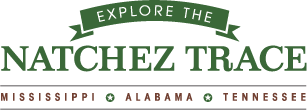NATCHEZ, MS – With the help of volunteer researchers, Natchez Trace Parkway (Parkway) staff members have identified the gravesite of Paris Martin, who was an enslaved person at the Mount Locust Plantation before the Civil War. Paris Martin’s final resting spot was unknown to Parkway staff until this summer when local genealogy researchers joined the search for his burial location.
After learning about Paris Martin’s story through a Parkway Facebook post, a dedicated group of users combed through online and archival sources to find clues to Paris Martin’s final resting place. One visitor went so far as to pull Paris Martin’s death certificate, which was on file at the Mississippi Department of Archives and History in Jackson, MS. His death certificate proved to be the clue that broke the case open, listing Jefferson Chapel as Martin’s place of burial. A few days later, Parkway staff members confirmed the location of Martin’s gravesite and identified his worn but still present government veteran’s headstone.
Paris Martin was one of over 100 enslaved persons held in bondage at the Mount Locust Plantation before the Civil War. During the war, Martin escaped from slavery and joined the 50th United States Colored Troops (USCT) in Natchez, Mississippi, in July 1863. He survived the war and was discharged from the United States Army in 1866. He returned to live in Jefferson County, Mississippi, near Mount Locust until he died in February 1917. He was buried at Jefferson Chapel AME Church in Church Hill, Mississippi, just a few miles from the Parkway and Mount Locust.
Jefferson Chapel AME Church was founded in the years just before the Civil War by Reverend George White to serve the large local enslaved population. After the Civil War, the church prospered as many formerly-enslaved persons from the surrounding area, including several from the Mount Locust Plantation, joined the congregation and celebrated their newly won freedom. Although membership and participation have waxed and waned in the intervening 150 plus years, Jefferson Chapel still has a dedicated, albeit smaller, congregation. Jefferson Chapel holds regular services on the first Sunday of the month; Reverend Emma Scott officiates.
The search to find more about Paris Martin and the enslaved people who lived at Mount Locust continues. Soon, Parkway staff members hope to reach out to descendants of the Martin family who still reside in the local area. Paris Martin is just one of several slaves connected to the Mount Locust Plantation that park staff members have been researching. Several former slaves who later served with the USCT during the Civil War have been identified, including Paris Martin’s brother, Anthony Martin; his final resting place remains unknown.
Interested visitors can follow the story and help research more about the enslaved people of Mount Locust by accessing the Parkway’s Facebook page at facebook.com/NatchezTraceParkwayNPS. Join in the conversation there or email the Mount Locust site lead, Park Ranger Jacob Dinkelaker (jacob_dinkelaker@nps.gov), who continues to coordinate the ongoing research.
Mount Locust Inn and Plantation are located at milepost 15.5 on the Parkway near Natchez, Mississippi. It is open to the public Thursday through Sunday from 9:00 am to 4:30 pm.
